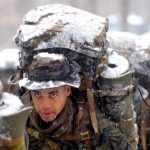
America fell apart after the October 2013 Debt Ceiling/Obamacare fiasco. The politicos ‘running’ the country agreed-to-disagree and inevitably kicked off the national default. The pain of endless magical government money disappearing had no ripple effect, it was more like all the dominoes falling down at the same time. Thousands of honorably disabled military veterans, some just home from Afghanistan, took the hit straight to the gut when the VA ran out of money. Many of these vets depended on these hard earned monthly checks from the VA to keep up with bills and keep themselves and family fed. Poverty quickly moved their way. Thousands of vets using the GI Bill to pay for college also got the ‘sorry but…’ letter from the VA as they too became victims of their government’s inability to do anything efficiently, responsibly, and honestly. Welfare recipients were not exempt from the economic crash. Honest blue collar workers down on their luck and barely making ends meet lost the financial aid, they knew nothing more than to take it on the chin and keep pressing on. The equivalent of career politicians in the welfare receipt world suffered the most from the demise of welfare. These individuals, able bodied masters of ripping off state and federal governments, depended on welfare for every aspect of their lives. Food stamps, free medical coverage, etc., they had it all but lied to get it. Ms. Karma struck with a vengeance as they would soon become very hungry able bodied individuals with no free rides to keep them alive.
Our imaginary friend Kenny was around for all this drama. He was smarter than the average bear and relatively prepared for a short term nationwide crash. Days spent on YouTube guided his emergency preparedness buys like food and water storage, ammunition and firearms, and barter items. Unfortunately, he was never able to buy common sense and sound judgment, especially when it came to using his ‘Prepper/SHTF’ toys. Kenny saw the news coverage of big city riots where hungry maddened people took to the streets in a Rodney King-esque fashion. He understood their looting of grocery stores as they were not OK with starving. Eventually the looting grew to include murder and rape on a grand scale. The bloody snowball was going wild and rolling out of big cities into not so big cities. Martial law by way of the military became the norm but fell apart when troops could not be paid and decided to head home to care for their families. Organized banditry was the new threat to be fought and Kenny was part of fighting the good fight. Refugee camps sprang up along the US-101 north of LA (aka: Hell-A) as the thuggery got worse in the city. The better organized gangs occasionally raided these camps a la Viking with typical raping, pillaging, and burning. Although a citizens defense force was forming to keep the criminals at bay, Kenny preferred to play the lone-wolf card. Bad idea.
So there goes our dumb friend Kenny into the beautiful rolling hills of southern California in search of ‘bad guys’. Along the way he befriends a fellow lone-wolfette, Ms. Stone of the ‘Green Hill Rangers’. Stone eventually dropped out of the operation due to unseen ‘blisters’ on her feet, “I just know they are there” she said. Her exodus had nothing to do with his creepy stares and insistence on walking behind her while they hiked uphill. As a parting gift, Stone gave our idiot hero Kenny a scoped SR-25 rifle, magazine inserted and ready to rock and roll. Now he would really ‘bring it’ to the marauding scum that prowled what he called the “Central Southern Highlands.” The next morning Kenny rolled out of his 13 pound modular sleeping system and got ready for breakfast. From his half-ton Alice pack he produced a bag of powdered eggs, some pancake mix, a bottle of maple syrup, a cigar, a cast iron skillet, and a propane stove. This guy traveled in style. His stove didn’t work so he fired up some twigs and branches to get his breakfast cooked, bad idea. Hours later he got back to work and found what he was looking for, one platoon sized unit of motorized thugs stretching their legs just off the US-101. From behind absolutely no cover and concealment, Kenny flipped the SR-25 to fire and pulled the trigger on his nearest target. He heard a quick ‘pfffft‘ sound and saw no effects on target. He thought, “Ms. Stone said nothing of an internal silencer?”. He sat up for a second shot at his 500 m target and was annoyed at the wind pushing dust into his side and rustling leaves. ‘Pfft‘ again, then the lack of recoil woke him up. He removed the magazine and saw a white pellet near the top. He cried, “DAMN YOU GREEN HILL AIRSOFTERS!” His loud objection drew the attention and incoming fire from his would be targets. Kenny had one good thing going for him, a Colt 6920 Carbine. The 5.56mm firearm was nearly stretched to its limits at 500 m but more than capable of accurately engaging his targets. Kenny chambered a green tip round, set his rear sight elevation to 5, and began engaging his targets. He had no idea that his centered rear windage was allowing the wind to move his rounds almost one foot to the left of his targets. Three magazines worth of zero hits later and Kenny was toast. The thugs had common sense and bounded towards him at a steady pace. He was eventually suppressed by their fire and one well aimed AK did him in.
Slowly, Kenny’s soul drifted up from his cooling lifeless body. He noted the following:
“Why was I carrying so much unnecessary gear?”
“Why don’t my clothes match the terrain?”
“Why did I shoot from an unconcealed/uncovered position?”
“Why did that cute girl give me an airsoft gun?!”
“Why did I miss?”
Kenny’s last drifting soul question is what we will cover in our next post. One reason why Kenny missed was due to his lack of a wind call. An accurate wind call is one of the factors that separate hits from misses. Our dearest Kenny would have had a fighting chance if he applied the fundamentals of marksmanship. Don’t be fooled by anyone that tells you wind can’t be beat. If a platoon of Marine recruits can punch holes in a man sized target at 500 meters against wind, so can you! Put yourself in Kenny’s shoes. What you have done about your surprise SR-25 airsoft rifle? Best comment gets a t-shirt courtesy of Guiles Hendrick.
Sgt. G, LMS Contributor
All Rights Reserved




 To perform the Owen Technique®, the flashlight is held by the thumb as the light rests inline and on top of the area between the knuckle and middle joint of the index finger when using a shooting grip with the wrist pointed forward and locked out. The hand and light positioning allows for the weak side index finger to point forward with the gun or wrap the trigger guard depending on shooter preference and size of the light and handgun. The remaining weak hand fingers wrap around the pistol grip over the strong side fingers per a normal grip. The strong side grip is virtually left unchanged other than the thumb, which still wraps the handgun’s pistol grip but stays slightly
To perform the Owen Technique®, the flashlight is held by the thumb as the light rests inline and on top of the area between the knuckle and middle joint of the index finger when using a shooting grip with the wrist pointed forward and locked out. The hand and light positioning allows for the weak side index finger to point forward with the gun or wrap the trigger guard depending on shooter preference and size of the light and handgun. The remaining weak hand fingers wrap around the pistol grip over the strong side fingers per a normal grip. The strong side grip is virtually left unchanged other than the thumb, which still wraps the handgun’s pistol grip but stays slightly



